
by Dr Patrick Forth
“When you’re from here, you don’t have aspirations.”
This was a sobering comment made by a student from a school in a disadvantaged community after being asked to write down their life’s aspirations. The whole class submitted blank papers to their teacher that day. Sadly, this isn’t an isolated issue.
Australia is currently facing an education equity crisis. Programme for International Student Assessment (PISA) data reveals that 70% of students from disadvantaged backgrounds didn’t achieve national proficiency standards in maths, compared with 28% from advantaged backgrounds. As Minister Clare has stated, we have high and worsening levels of segregation. The 2023 National Assessment Program – Literacy and Numeracy (NAPLAN) data echoes this with yawning gaps in attainment levels between Indigenous and non-Indigenous students, and those in metro and regional areas.
The sustained outperformance of students from expensive private schools drives their much higher share of tertiary education and perpetuates their dominance in positions of power; yet studies continuously show that diversity of all kinds drives innovation and better economic outcomes. We’re preventing talented children from realising their potential and further contributing to the country’s prosperity and innovation.
Right now, the Federal government appears determined to improve the status quo. It has undertaken many reviews to develop a clear plan focused on equitable educational outcomes – with support from State governments. Proposed investments, such as the Commonwealth’s High Achieving Teachers Program expansion, as well as Victoria’s ‘free secondary teaching degrees’ are important.
With severe teacher shortages disproportionately impacting schools in regional, remote, and disadvantaged communities, education experts know placing more teachers in these schools is crucial for success. Shockingly, young people in these schools are five times more likely to have a teacher unqualified in the subject they are teaching; which has been compounded by the impacts of COVID.
This means it’s vitally important that the profile of teaching is raised. The federal government’s ‘Be That Teacher’ campaign highlights how teachers can positively impact students and encourages Australians to consider a career in education. This must also be paired with accessing more funding, as per the Schooling Resource Standard.
As per recommendations from Professor Mark Scott, Vice-Chancellor of the University of Sydney, we need innovation in Initial Teacher Education (ITE) to enable a more practical approach to deliver confident, effective and classroom-ready graduates.
Reducing the administrative burden on teachers by using technology for fast and engaging lesson design, growing evidence-based approaches to teaching, great school leadership and community support will help close the gap in education attainment levels.
We know great outcomes are possible for remote schools when we get this right. The Sink Hole Preservation Project at St Joseph’s College in the remote Northern Territory town of Katherine is a good example. Combining science, environmental conservation and experiential learning, the project helped build understanding between the school and Aboriginal and Torres Strait Islander students and gained the community’s support. The combination of strong leadership, an injection of high calibre teachers and innovative thinking, led to greater retention of First Nations students at the school completing their senior years.
However, systemic change in education is hard – there’s still a risk that change doesn’t take hold. The two critical words to ensure success are ‘sustained alignment.’
Alignment amongst the many stakeholders in the education system, often with different perspectives and priorities, is essential. We all need to see the status quo as the enemy, and work to reconcile individual stakeholder objectives with achieving the bigger goal for our children.
Federal and State governments need to hammer out the necessary funding agreements; Unions play a major role in making the teaching profession more attractive; ITE providers can innovate to significantly enhance teacher effectiveness; and we must harness the tremendous passion and resources of the philanthropic and not-for-profit sector. Bickering, procrastinating, protecting vested interests and finger-pointing will only slow the progress of change.
The determination to succeed must also be sustained. Ten-year funding agreements would enable greater financial stability to underpin innovation and create evidence-based outcomes from pilots, with the ability to scale successful initiatives and stop funding those that don’t drive outcomes.
At Teach For Australia, we’re committed to being part of a systemic solution, helping to catalyse change as fast as possible. We’ve already placed around 1600 additional, high-quality teachers in classrooms – 100% of whom teach in disadvantaged communities – impacting around half a million students to date. 86% of our alumni continue to work in the education sector after their two-year placement.
The need to step up has never been more pressing. We have the components of the solution, and the leadership to create educational equity in Australia.
We cannot fail tomorrow’s leaders in the classroom today. Let’s ensure that all of Australia’s children have exciting aspirations.
Dr Patrick Forth is the Chair of Teach For Australia, a not-for-profit organisation which aims to address educational inequity in Australia.


